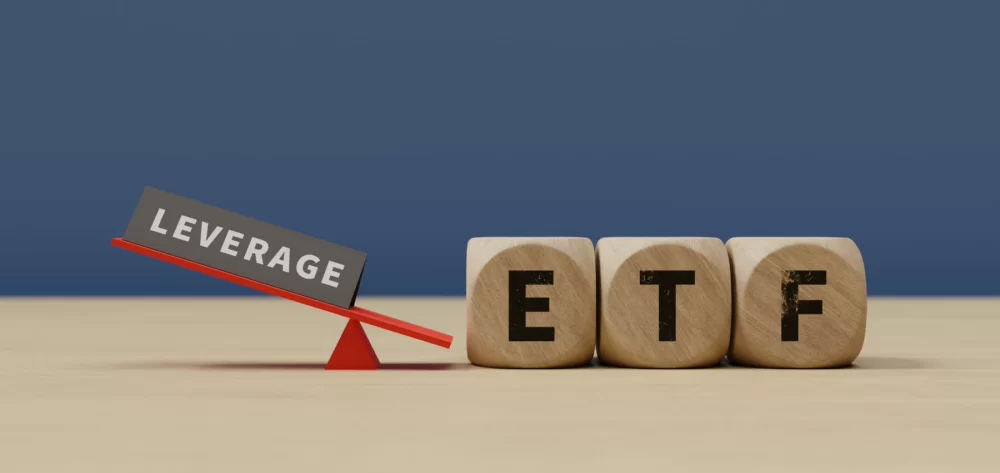It sounds tempting: You invest in a major stock index using an exchange-traded fund (ETF), but earn double the returns by using leverage. Using leveraged ETFs can, in some cases, enable you to increase the returns from your ETF investments. This moneyland.ch guide tells you what to consider before investing in leveraged ETFs, and explains the risks.
What is a leveraged ETF?
A leveraged ETF amplifies both the positive and negative developments in the rate of the stock index it replicates. ETF issuers use derivatives to achieve the leveraging effect. Unlike some other leveraged investment vehicles, there is no risk that you will have to pay in additional money to top up a margin. The leverage is built into the ETF, so to speak. In exchange, the ongoing fees charged by the ETF (shown as the TER) are normally higher than those of a non-leveraged ETF for the same index.
Example of the leveraging effect: If the value of the replicated index were to fall by 0.25 percent on a trading day, the value of an ETF with a two-to-one leverage ratio would fall by 0.5 percent. The opposite is also true: If the index went up by 0.25 percent, the leveraged ETF would gain 0.5 percent in value.
Leveraged ETFs typically work around a daily reset. That means the leverage is reapplied every day. Resultingly, the leverage factor only applies to the day’s performance, and not the returns achieved over a month or year. Because of that, the long-term performance of a leveraged ETF can deviate strongly from the performance of the index it replicates. For example, a two-to-one leveraged ETF will not necessarily perform twice as well or twice as poorly as the underlying index over periods longer than a day.
ETFs that are subject to European UCITS guidelines cannot use a leverage ratio higher than two-to-one. There are other leveraged investment vehicles that use higher leverage ratios, such as some exchange-traded notes (ETNs) and contracts for difference (CFDs).
Which leveraged ETFs are available to private investors?
The list of leveraged ETFs that are available to Swiss private investors is small, and only a few indexes are replicated. Stock indexes that you can invest in using leveraged ETFs include major US stock indexes like the Nasdaq 100 and the S&P 500, the German DAX index, and the Eurozone index Euro Stoxx 50. There currently are no ETFs that replicate global stock indexes or Swiss stock indexes (as per February 2025).
Table 1: Examples of leveraged ETFs
| ETF |
ISIN |
Domicile of fund |
TER |
Dividends |
Replication |
| Index: DAX |
Amundi LevDax
Daily (2x) leveraged
UCITS ETF Acc |
LU0252634307 |
Luxembourg |
0.35% |
Accumulating |
synthetic
(swap-based) |
Amundi LevDax
Daily (2x) leveraged
UCITS ETF Dist |
LU2090062600 |
Luxembourg |
0.35% |
Distributing |
synthetic
(swap-based) |
Xtrackers LevDAX
Daily Swap
UCITS ETF 1C |
LU0411075376 |
Luxembourg |
0.35% |
Accumulating |
synthetic
(swap-based) |
L&G DAX
Daily 2x Long
UCITS ETF |
IE00B4QNHH68 |
Ireland |
0.40% |
Accumulating |
synthetic
(swap-based) |
| Index: Euro Stoxx 50 |
Amundi EURO STOXX 50
Daily (2x) Leveraged
UCITS ETF Acc |
FR0010468983 |
France |
0.40% |
Accumulating |
synthetic
(swap-based) |
| Index: Nasdaq-100 |
Amundi Nasdaq-100
Daily (2x) Leveraged
UCITS ETF Acc |
FR0010342592 |
France |
0.60% |
Accumulating |
synthetic
(swap-based) |
| Index: S&P 500 |
Xtrackers S&P 500
2x Leveraged Daily Swap
UCITS ETF 1C |
LU0411078552 |
Luxembourg |
0.60% |
Accumulating |
synthetic
(swap-based) |
Source: ETF issuers and Justetf.com. Date: February 10, 2025.
In order to invest in an ETF, you first need to have a stock brokerage account at a bank or other stockbroker. You can compare Swiss stockbrokers using the interactive online trading comparison on moneyland.ch. Paying too much for brokerage fees and custody fees will have a negative effect on the performance of your investments.
The neobanks Neon and Yuh cannot currently be used for leveraged ETF investments. While it is possible to invest in ETFs using these neobanks, neither Neon nor Yuh offers leveraged ETFs at this time (as per February 2025).
What are the risks and disadvantages of leveraged ETFs?
Leverage both boosts the potential returns, and amplifies the risk of loss. For example, if the Nasdaq 100 were to decrease by 0.5 percent in one trading day, a leveraged Nasdaq 100 ETF would lose 1 percent of its value. Depending on the leverage ratio used and the performance of the benchmark index, it is possible to make massive losses within a very short amount of time. Any losses are multiplied when you use a leveraged ETF.
There are additional risks that you should consider before investing in a leveraged ETF:
- High ongoing costs: Compared to regular non-leveraged ETFs, leveraged ETFs have much higher ongoing fees (shown as the TER). That is because the use of derivatives and debt to leverage positions creates an additional cost for the fund’s managers. Fees have a negative impact on returns.
- Small selection: At this point in time, leveraged ETFs can only be used to invest in a handful of stock indexes. These include the US stock indexes Nasdaq 100 and S&P 500, the European stock index Euro Stoxx 50, and Germany's main stock index, the DAX. There currently are not any leveraged ETFs that replicate global indexes like the MSCI World, or Swiss indexes like the SMI or the SPI (as per February 2025). That makes it impossible to create a globally diversified stock portfolio using just leveraged ETFs.
- Daily reset: The leverage ratio is always applied to the daily performance. As a result, the long-term performance of a leveraged ETF can deviate sharply from that of its underlying index. Because the nominal value of your investment is reset on a daily basis, a loss in the ETF’s value on a trading day essentially translates into a capital loss. This can result in huge losses within just a few trading days.
- Volatility drag: High volatility takes a negative toll on leveraged ETF investments. Index volatility will cause a leveraged ETF to lose value, even over periods when the index’s value remains the same, on average. This phenomenon is referred to as the volatility tax, or as volatility drag. The volatility tax results in a poorer risk-to-return ratio. The higher the leverage ratio used is, the bigger the volatility tax is. The example in Table 2 shows you how volatility drag works.
Table 2: Example of volatility drag
| |
Without leverage |
With 2X leverage |
| Value on day 1 |
CHF 50 |
CHF 50 |
| Value on day 2 |
CHF 49 (-2%) |
CHF 48 (-4%) |
| Value on day 3 |
CHF 50 (+2%) |
CHF 49.92 (+4%) |
| Value on day 4 |
CHF 48.50 (-3%) |
CHF 46.92 (-6%) |
| Value on day 5 |
CHF 50 (+3%) |
CHF 49.74 (+6%) |
| Change in value over the 5-day period |
CHF 0 (0%) |
CHF -0.26 (-0.52%) |
How well do leveraged ETFs perform?
There is no answer that applies across the board. How the value of a leveraged ETF develops depends on the performance of the underlying index, the leverage ratio used, and the length of the investment term. Important: It would be foolish to assume that an ETF with a two-to-one leverage ratio will perform twice as well as the underlying index. The leverage only applies to the daily performance, and not to long-term performance. The impact of volatility drag, on the other hand, becomes more visible over longer terms.
The performance comparison of leveraged and non-leveraged ETFs in Table 3 indicates that leveraged ETFs performed better than their non-leveraged counterparts over both five-year and 10-year terms. That is true for all of the indexes included in the comparison.
Table 3: Performance comparison of select leveraged and non-leveraged ETFs
| ETF |
Leverage
ratio |
5-year-performance
in CHF (2020-2025) |
10-year-performance
in CHF (2015-2025) |
| Index: DAX |
Amundi LevDax
Daily (2x) Leveraged
UCITS ETF Acc |
2x |
61.00% |
104.96% |
Xtrackers DAX
UCITS ETF 1C |
No
leverage |
37.97% |
71.95% |
| Index: Euro Stoxx 50 |
Amundi EURO STOXX 50
Daily (2x) Leveraged
UCITS ETF Acc |
2x |
64.33% |
134.64% |
Invesco EURO STOXX 50
UCITS ETF |
No
leverage |
40.23% |
86.62% |
| Index: Nasdaq-100 |
Amundi Nasdaq-100
Daily (2x) Leveraged
UCITS ETF Acc |
2x |
207.97% |
1242.16% |
Invesco EQQQ Nasdaq-100
UCITS ETF |
No
leverage |
118.83% |
435.27% |
| Index: S&P 500 |
Xtrackers S&P 500
2x Leveraged Daily Swap
UCITS ETF 1C |
2x |
135.33% |
533.91% |
SPDR S&P 500
UCITS ETF (Dist) |
No
leverage |
80.19% |
236.96% |
Sources: Fund issuers and Justetf.com. Performance in CHF, including dividends. Dates used for performance calculations: February 6, 2015; February 6, 2020; February 6, 2025.
It is very important to understand that past performance is never an indicator of future price developments. There is no way to accurately predict how the value of an asset will develop. The strong past performance should not distract you from the fact that leveraged ETFs are high-risk investment vehicles.
Who can benefit from leveraged ETFs?
Leveraged ETFs are only suitable for investors with a high risk capacity who are able to cope with severe fluctuations. That is important because volatility is greatly amplified for leveraged ETFs, compared to non-everaged ETFs.
Make sure you are fully aware of the potential risks. A major crisis or a strong price correction will take a much bigger toll on a leveraged ETF. In a worst-case scenario, you could theoretically lose most of your investment within a very short period of time. Even a total loss cannot be ruled out. For that reason, you should never invest money in leveraged ETFs if you cannot afford to lose that money completely.
Are there any other ways to invest with leverage?
Leveraged exchange-traded notes (ETNs) are a possible alternative to leveraged ETFs. Investing in ETNs is much like investing in ETFs. Like ETFs, you can buy and sell ETNs using a stockbroker.
However, an ETN is only a debt claim against its issuer, and the underlying assets are not segregated in the event that the issuer goes bankrupt. Unlike ETFs, ETNs are not subject to UCITS limitations, so there are ETNs with leverage ratios higher than two-to-one.
Table 4: A selection of leveraged ETNs
| ETN |
ISIN |
Domicile |
TER |
Dividends |
Replication |
| Index: DAX |
WisdomTree DAX
3x Daily Leveraged |
IE00B878KX55 |
Ireland |
0.75% |
Accumulating |
synthetic
(swap-based) |
| Index: Euro Stoxx 50 |
WisdomTree EURO STOXX 50®
3x Daily Leveraged |
IE00B7SD4R47 |
Ireland |
0.75% |
Accumulating |
synthetic
(swap-based) |
| Index: Nasdaq-100 |
WisdomTree NASDAQ 100
3x Daily Leveraged |
IE00BLRPRL42 |
Ireland |
0.75% |
Accumulating |
synthetic
(swap-based) |
| Index: S&P 500 |
WisdomTree S&P 500
3x Daily Leveraged |
IE00B7Y34M31 |
Ireland |
0.75% |
Accumulating |
synthetic
(swap-based) |
Source: ETN issuers and Justetf.com. Date: February 10, 2025.
There are also other derivatives that can be used to speculate on price developments. These leveraged products are not suitable for inexperienced investors. Examples include:
Disclaimer: This article is provided for informational purposes only, and should not be seen as investment advice. The publishers do not accept any liability in connection with this publication.
More on this topic:
Compare Swiss stockbrokers now
How to invest money in Switzerland
Checklist for choosing the right ETF
Risk categories for mutual funds and ETFs explained


 Deal of the Day
Deal of the Day 




